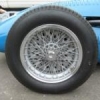So at some point I read that some hotrodders were using plain bearing in plain bearing mains or big ends. These were known as double slippers. That is you have a conventional bearing with a very large clearance, and in the gap you stuff an extra bearing shell, giving you two low speed oil films rather than one high speed oil film. Or for the cynical, if one seized you still had a bearing..
Did I make this up?
If not anybody have any pictures or other information?
Bourke even mentioned a triple slipper.
















